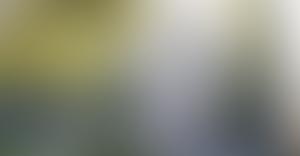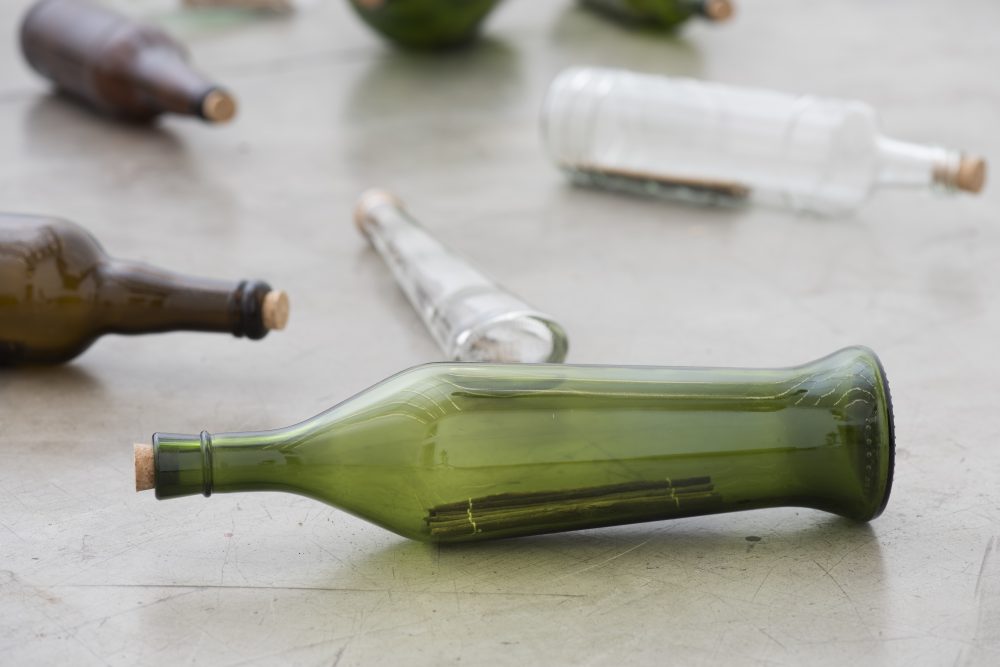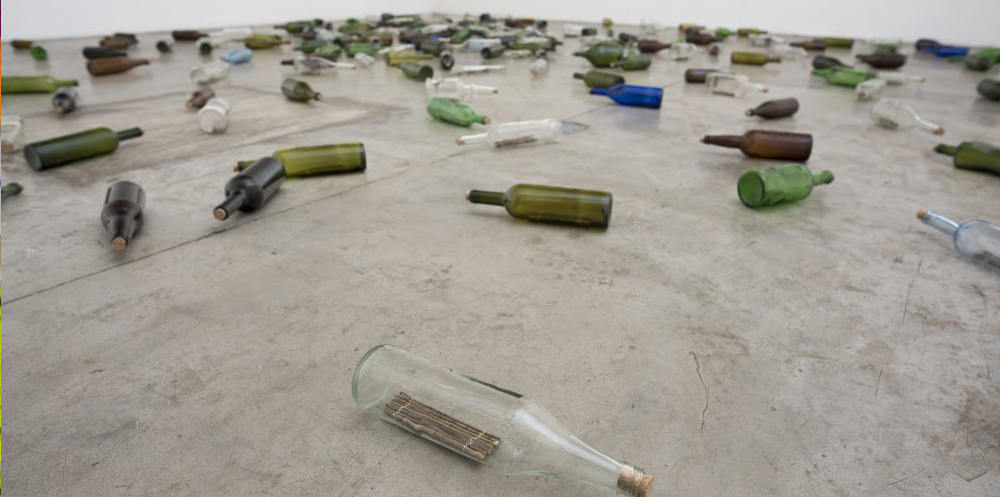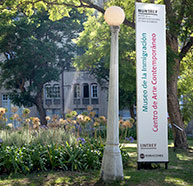-
Carla Zaccagnini: Tomorrow was going to be yesterday


-
Carla Zaccagnini: Tomorrow was going to be yesterday


-
Curators text
This project has been carried out by the Argentinean-Brazilian artist Carla Zaccagnini (Buenos Aires, 1973) specifically for the rooms of the old Immigrants Hotel. Under the title Mañana iba a ser ayer, she reviews her family history through five new pieces, the result of research carried out during these last years. Exploring the complex intersection between subjective history and social history and exploring the ways in which inheritance is elaborated and manifests itself, the exhibition portrays the migratory and integration processes that the artist’s grandfather went through during the 20th century.
The piece El mar que ves nunca será el mar que yo vi (The Sea You See Will Never be the Sea I Saw), which initiates the exhibition, is made up of two hundred glass bottles containing a raft inside. Placed under the windows overlooking the banks of the river, these bottles are a sign of distance and displacement, a visual form of the intermediate space involved in migration: neither inside nor outside a culture, often between languages, a complex and relational zone that, in Zaccagnini’s case, has been inhabited by both her grandfather and herself.
As in other of her works, in which she has been interested in feminist protests, in museums or in the figure of the traitor during colonialism in Brazil, Zaccagnini juxtaposes dissimilar stories to reveal the echoes and invisible genealogies that unite them. The artist has called this procedure “Bifurcations and Crosses“, which allows her to compare elements that do not seem connected at first glance, but that a more exhaustive look ends up proving identical. Thus, in Película hablada (Spoken movie), the artist suggests that in the sinking of the luxury liner Principessa Mafalda and in the death of the princess who named the ship, the failure of the modernizing project of the late nineteenth century could be coded and that the tannery that her grandfather set up in the forties could condense the industrial utopia of the mid-twentieth century.
The grandfather’s possibility of making several trips to Italy and his regular trips to Brazil, his incipient internationalism or the development of activities related to luxury consumption link the grandfather in a series of duplications with the figure of the contemporary artist. Without being part of the European “advanced civilization” called by Sarmiento, which established itself above all in rural spaces, and without being part of the internal immigration called by Perón to work in factories, grandfather Zaccagnini is a very different immigrant compared to the traditional stories that Argentina knows. He settled in the country around the 1940s, after numerous travels in which he acted as a marchand between Argentina and Europe. Dislocated territorially, but also between two imaginaries about immigration, Película hablada traces in some of the economic undertakings that the family carried out (a tannery, an estancia named La Fortuna, the breeding of silkworms) the changing relationship between nature and industry, country and city, localism and internationalism proposed by the different modernizing projects from the end of the 19th century to today.
The game of mirrors organized by the stories insists on the artist’s deep interest in optical mechanisms. The unfolding of images, the interruption of films and the exhibition of the technology of reproduction of images are some of the resources with which Zaccagnini intensifies and points out the act of seeing. In Direction and Sense, she creates a super 8 reproduction mechanism in which the heads of a lamp interfere and create a play of lights on the projection. The film (also the furniture that forms part of the exhibition) was found by the artist in the family country house. It contains domestic scenes that, like the first-person narration in Spoken Film, sift what we see in the light of testimony, orality and memory. With this, the artist investigates the way in which stories and images construct ideologies and vital trajectories, while emphasizing the individual and subjective protagonism in the construction of our lives.
The relationship of care and protection that a child – Carla’s father, probably – establishes with a turtle begins the filming of super 8. The caress and embrace of the child contrast with the leather goods that the tannery manufactured from another amphibian, the caiman. Zaccagnini duplicates and reverses the gesture of the tanner on a paper, drawing alligators with the same pencil that the tannery used to mark his skins. Without questioning the extractive activities that marked the 20th century-and that also signify the present day, Zaccagnini’s loving and revisionist gesture wonders about other possible links with our history and with what surrounds us.
Lucrecia Palacios and Agustín Pérez Rubio
Curators
-
WORKS LIST
Carla Zaccagnini / Tomorrow was going to be yesterday
The sea you see will never be the sea I’ve seen.
2016-2019
200 different bottles, 200 handmade rafts, 200 stoppers
Variable dimensions
Courtesy of the artist and Vermelho Gallery, San Pablo.
Drawing Alligator I
2018
Leather marking pencil on paper and leather marking pencil
100 x 145 cm
Drawing Alligator II
2018
Leather marking pencil on paper and leather marking pencil
100 x 163 cm
Drawing Alligator III
2018
Leather marking pencil on paper and leather marking pencil
100 x 165 cm
Drawing Alligator IV
2018
Leather marking pencil on paper and leather marking pencil
75 x 145 cm
Drawing Alligator V
2018
Leather marking pencil on paper and leather marking pencil
75 x 160 cm
Cooked and raw
2019
Alligator leather and alligator leather suitcase. Tannery Zaccagnini, 1940s
190 x 70 x 20 cm
Direction and sense
2018-2019
Projection of film of 16mm intervened with rail of caireles of crystal of Baccarat
6´33”
Produced with the support of The Royal Danish Academy of Fine Arts, School of Visual Arts, Copenhagen.
Spoken film
2017-2019
Installation of three video channels, furniture belonging to estancia La Fortuna and documents from family archives.
38’
Produced with the support of The Royal Danish Academy of Fine Arts, School of Visual Arts, Copenhagen.
Family furniture belonging to estancia La Fortuna
Showcase and family documents belonging to estancia La Fortuna
SOME WORKS
1*
Eraser for telegram (1940)
2*
Worm cocoon and silk thread produced in Estancia La Fortuna, province of Buenos Aires (1950)
3*, 4* y 5*
The sea you see will never be the sea I’ve seen.
2016-2019
200 different bottles, 200 handmade rafts, 200 stoppers
Courtesy of the artist and Vermelho Gallery, San Pablo.
Photo: Edouard Fraipont
6*
Drawing alligator I (2018)
Leather marking pencil on paper and leather marking pencil
100 x 145 cm
7*
Cooked and raw (2019)
Alligator leather and alligator leather suitcase.
Tannery Zaccagnini, 1940s
8*
Direction and direction (2018-2019)
Projection of film of 16mm intervened with rail of caireles of crystal of Baccarat
6´33”
Produced with the support of The Royal Danish Academy of Fine Arts, School of Visual Arts, Copenhagen.
9* y 10*
Family furniture belonging to estancia La Fortuna
Family documents belonging to estancia La Fortuna
Venue
Center of Contemporary Art







